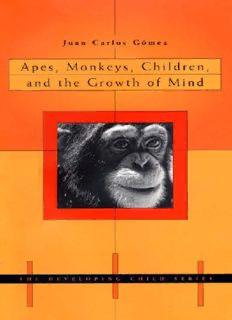
Apes, Monkeys, Children, and the Growth of Mind (The Developing Child) PDF
Preview Apes, Monkeys, Children, and the Growth of Mind (The Developing Child)
The Developing Child Bringingtogetherandilluminatingtheremarkablerecent researchondevelopmentfrominfancytoadolescence,for studentsofdevelopmentalpsychology,policymakers, parents,andallothersconcernedwiththefuture ofthenextgeneration. series editors JeromeBruner NewYorkUniversity MichaelCole UniversityofCalifornia,SanDiego AnnetteKarmiloff-Smith NeurocognitiveDevelopmentUnit,InstituteofChildHealth,London JosephJ.Campos UniversityofCalifornia,Berkeley Apes, Monkeys, Children, Growth of Mind and the Juan Carlos Gómez harvard university press Cambridge,Massachusetts,andLondon,England 2004 Copyright©2004bythePresidentandFellowsofHarvardCollege Allrightsreserved PrintedintheUnitedStatesofAmerica LibraryofCongressCataloging-in-PublicationData Gómez,JuanCarlos,1959– Apes,monkeys,children,andthegrowthofmind/JuanCarlosGómez. p.cm.—(Thedevelopingchild) Includesbibliographicalreferencesandindex. ISBN0-674-01145-7 1.Cognitioninchildren. 2.Psychology,Comparative. 3.Primates— Psychology. I.Title. II.Series. BF723.C5G652004 156.′5—dc22 2004042433 ToTriz, wholivedandlovedthroughallthatcame ATriz, yloquenaciódenosotros Contents Preface ix 1 Hands,Faces,andInfancy:TheOriginsof PrimateMinds 1 2 PerceivingaWorldofObjects 28 3 PracticalIntelligence:DoingThingswithObjects 58 4 UnderstandingRelationsBetweenObjects:Causality 94 5 TheLogicofObjectRelations 124 6 ObjectsintheWorld 150 7 Faces,Gestures,andCalls 173 8 UnderstandingOtherSubjects 204 9 SocialLearning,Imitation,andCulture 238 10 ConsciousnessandLanguage 266 11 LearningfromComparisons:TheEvolutionof CognitiveDevelopments 292 References 311 Index 333 Preface Whatcanthestudyofmonkeysandapestellusaboutthedevelop- ing minds of young human beings? This is the topic of this book, and the abiding interest of my academic career. My intention has been to write an introduction to this fascinating topic but at the sametime,withoutlosingreadability,todiscusssomeofthedeeper issues at the confluence of developmental and evolutionary cogni- tivesciences. Theargumentissimple:ourmindsarepartofawiderevolution- ary pattern discernible in the minds of other primates. Its most characteristicfeatureisdevelopmentasanadaptivestrategy.Inmost primates infancy and childhood have been extended over an in- creasingly higher proportion of the life span. Characteristically, primates have prolonged infancies and a slowed-down process of development, as if there were special benefits to be gained from this otherwise risky beginning. One of these benefits is the ability to get to know their worlds—both physical and social—in better detail and greater plasticity, and consequently, the ability to pro- ducemoreflexibleandadaptivebehaviors. Primates evolved hands and sophisticated visual and tactual sys- tems which have allowed them to discover and exploit a world made of natural objects. They also evolved a complex social life withintricaterelationshipsandelaborateinteractionsinwhichoth-
Description: